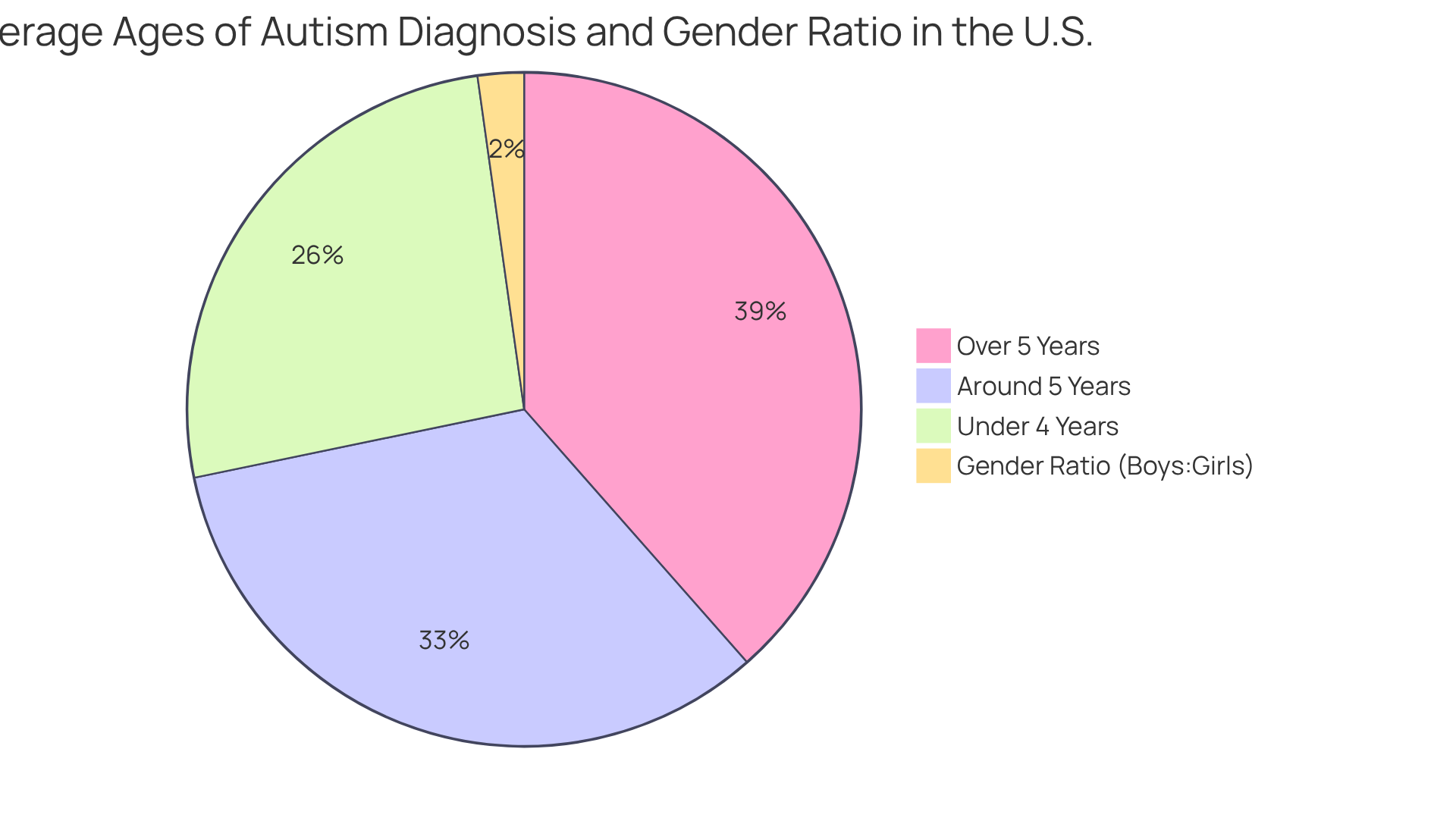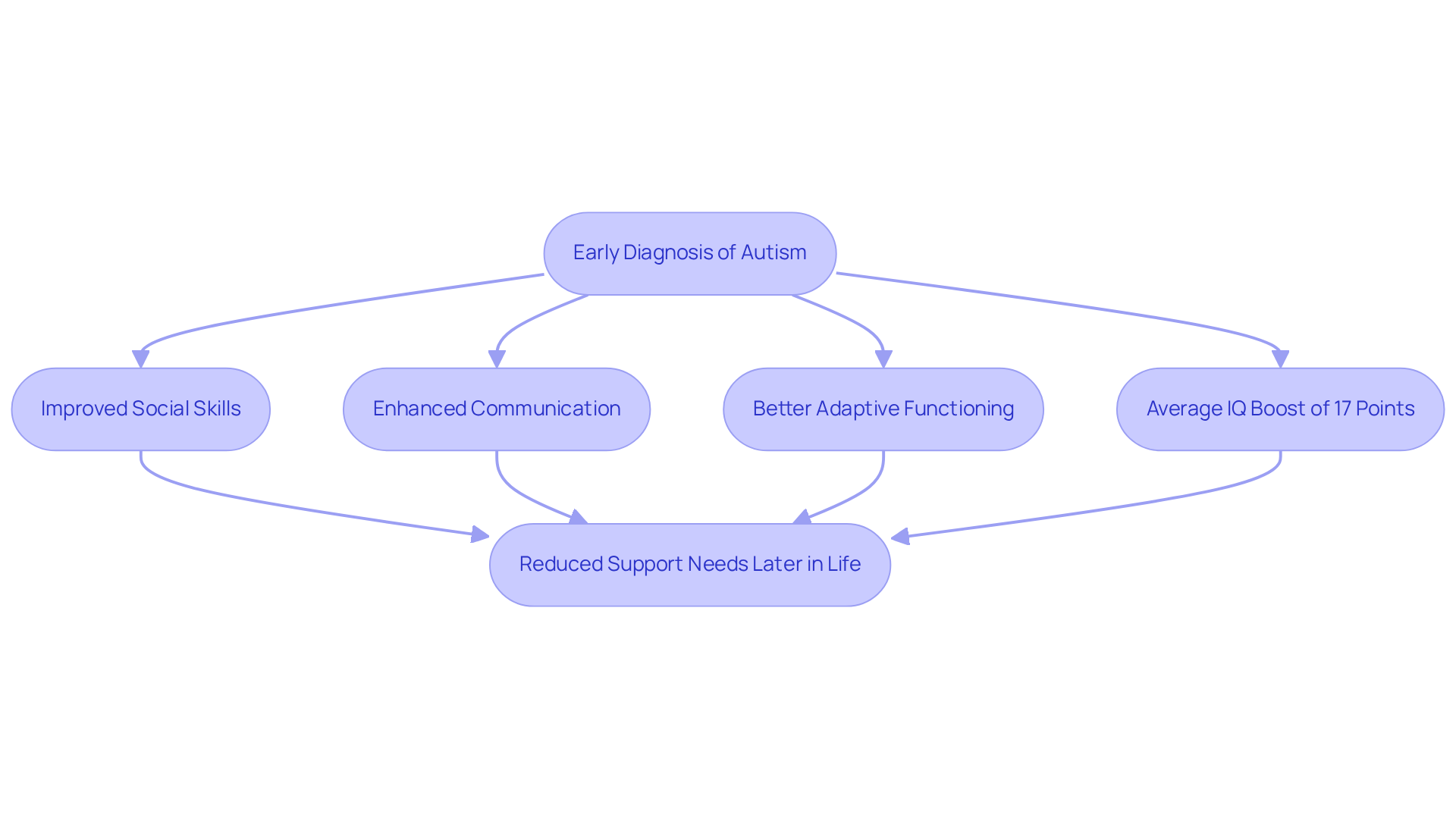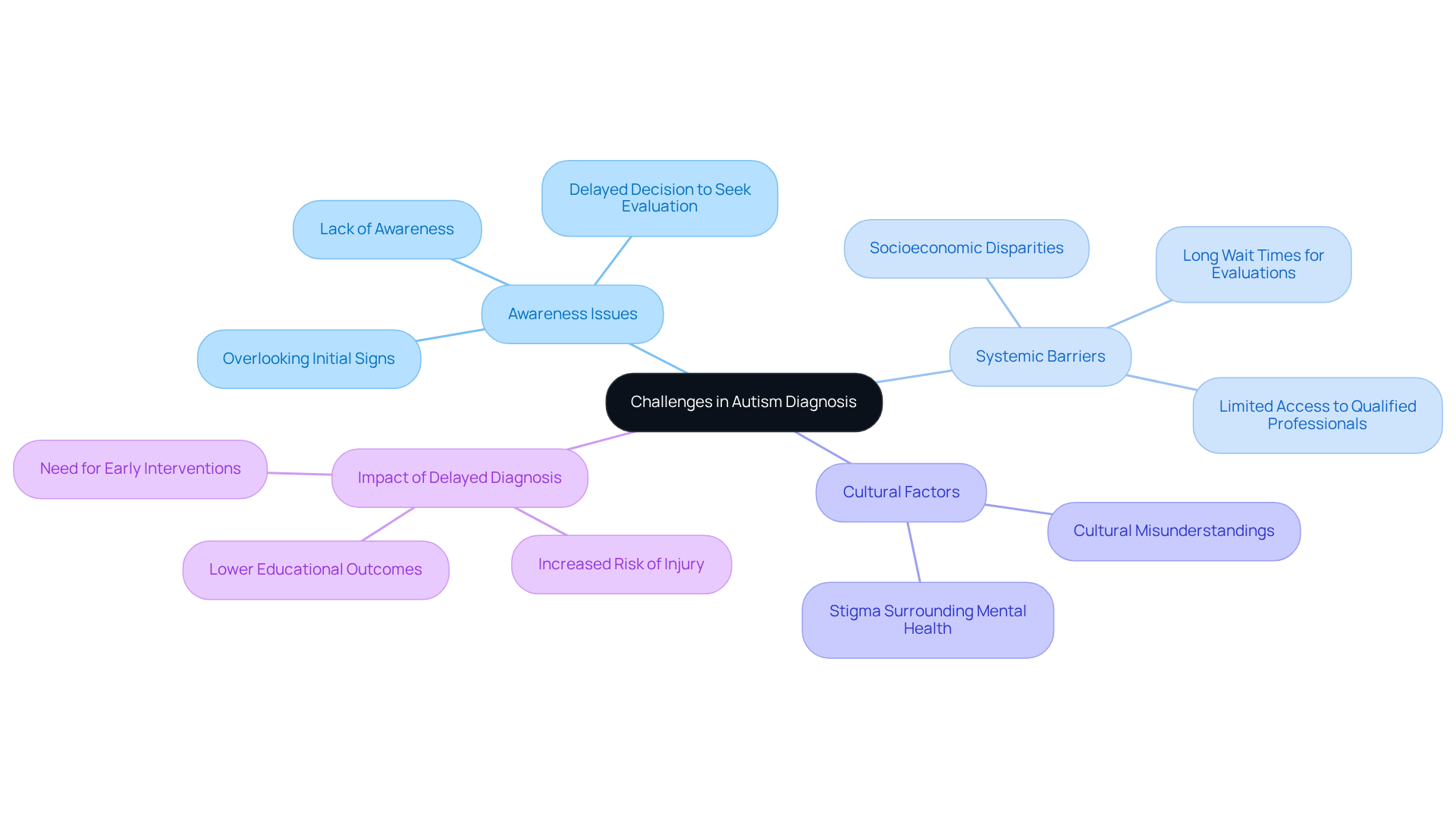Overview
In the United States, the average age for an autism diagnosis is around 5 years. However, many children are identified even earlier, at approximately 47 months. This early identification highlights significant regional and socioeconomic disparities in when diagnoses occur.
It's crucial to recognize that early diagnosis can be a game-changer. Accessing timely interventions can greatly improve developmental outcomes for children. Those diagnosed before the average age often show better social skills and adaptive functioning.
As parents, understanding this can inspire a proactive approach to seeking support and resources for your child.
Introduction
Understanding the age at which autism is diagnosed can significantly influence a child's developmental journey and their access to essential support services. With recent statistics showing that 1 in 36 children in the U.S. is diagnosed with autism, the need for timely identification has never been more pressing.
Yet, the disparities in diagnosis age tell a concerning story—many children, especially those from marginalized communities, experience delays that can hinder their potential. What factors contribute to these delays, and how can families and professionals collaborate to ensure that every child receives the timely intervention they deserve?
Together, we can create a path toward better outcomes for all children.
Define Autism Diagnosis and Its Importance
Understanding autism evaluation is crucial for families navigating the complexities of Autism Spectrum Disorder (ASD). This process involves identifying whether an individual meets the criteria outlined in diagnostic manuals like the DSM-5. Typically, it includes comprehensive evaluations that encompass behavioral assessments, developmental history, and insights from caregivers. The importance of an accurate assessment cannot be overstated; it serves as the gateway to essential interventions and support services that can profoundly impact a child's development.
Prompt identification is particularly vital, as it allows for timely actions that can significantly enhance developmental outcomes for youth facing these challenges. Recent statistics reveal that the average age of autism diagnosis has been affected by the rising diagnosis rate of developmental disorders, which now stands at 1 in 36 children in the U.S. as of 2023, a significant increase from the previous estimate of 1 in 44. For parents and professionals alike, understanding the diagnostic criteria and procedure is essential, as it directly influences the support and resources available to children with developmental disorders.
Moreover, studies indicate that children who are identified early, often before the average age of autism diagnosis, are more likely to receive personalized support services, leading to improvements in their social and communication skills. A systematic review has confirmed that early intervention can significantly alleviate the challenges associated with autism, highlighting the need for increased awareness surrounding the diagnostic process. It’s also important to recognize the racial and ethnic disparities in the identification rates of developmental disorders, as these factors can affect access to vital support services.
Additionally, the economic strain of raising children with developmental disorders underscores the importance of early identification and access to support. Families often face considerable financial challenges in securing necessary resources, making it all the more critical to act swiftly. By fostering a deeper understanding of the evaluation process and advocating for timely interventions, we can help ensure that every child receives the support they need to thrive.
Examine the Average Age of Autism Diagnosis
As of 2025, the average age of autism diagnosis in the United States is around 5 years. However, recent data reveals that many children are identified earlier, at about 47 months, which is just under 4 years. Yet, significant regional disparities remain, with some areas reporting cases identified as late as 69.5 months. Factors influencing this age of identification include:
- Socioeconomic status
- Access to healthcare
- The level of awareness among parents and healthcare providers regarding developmental disorder symptoms
The CDC highlights that while the condition can be reliably identified by age 2, many children do not receive an assessment until they are older. This delay can hinder access to essential interventions. For example, the average age of autism diagnosis for Black children is over 5 years, occurring approximately 3 years after parents first express concerns about their child's development. This underscores the urgent need for increased awareness and improved screening methods to ensure timely assessments and interventions.
Moreover, disparities in the timing of assessments are often linked to socioeconomic factors. Families with lower socioeconomic status face greater challenges in accessing healthcare and educational resources. Addressing these disparities is crucial for enhancing early detection and support for individuals on the autism spectrum.
It's also important to note that the prevalence of autism is higher in males than in females, with a diagnosis ratio of about 4:1. The CDC indicates that 1 in 31 children in the U.S. is diagnosed with a spectrum disorder, highlighting the broader context of prevalence within the population. Chris Abildgaard observes that the increase in recognized cases is due to heightened awareness and improved diagnostic methods, which are vital for fostering early detection.
Additionally, 49% of children with developmental disorders were assessed by age 3, emphasizing the importance of timely evaluation and intervention. Families with higher parental education levels tend to have earlier ASD identification, further illustrating the impact of socioeconomic factors on the timing of diagnosis. We encourage parents to share their experiences and seek support, as every step taken toward understanding and addressing these challenges can make a significant difference in the lives of children and families affected by autism.

Discuss the Impact of Early Diagnosis on Outcomes
Research consistently demonstrates that an initial diagnosis of autism is linked to significantly improved outcomes across various developmental areas. For parents, understanding that children diagnosed with autism before the average age of autism diagnosis, which is 2.5 years, often show remarkable advancements in social skills, communication, and adaptive functioning can be incredibly reassuring. In fact, studies reveal that youngsters diagnosed prior to 2.5 years are nearly three times more likely to demonstrate significant decreases in the intensity of social symptoms.
Moreover, prompt intervention services can lead to an average IQ boost of 17 points and substantial enhancements in daily living skills. This early identification allows families to access support services sooner, which can dramatically reduce stress and improve the overall quality of life for both the child and their family. Children who receive initial intervention tend to have better long-term outcomes, including higher rates of regular education attendance and employment in adulthood.
The importance of timely identification is profound; it lays the groundwork for effective intervention strategies, particularly when considering the average age of autism diagnosis, that can yield meaningful progress. Additionally, it is crucial to recognize the diagnostic disparities between genders, as these can impact the timing and nature of support received. Ultimately, children receiving early intervention are less likely to require extensive support services later in life, highlighting the long-term benefits of timely detection and treatment.
As you navigate this journey, remember that seeking help early can make a significant difference. Consider reaching out to professionals who can guide you through the process and provide the resources you need. Your child's future can be brighter with the right support in place.

Identify Challenges in the Autism Diagnosis Process
The journey to diagnose developmental disorders can be a challenging one, often leading to delays in identifying the support children need. A significant barrier lies in the lack of awareness and understanding of the symptoms among parents and healthcare providers. Many parents may overlook the initial signs of autism, which can delay their decision to seek an evaluation. The American Academy of Pediatrics recommends early screenings at 18 and 24 months, yet many young individuals remain undiagnosed until much later, which affects the average age of autism diagnosis.
Systemic issues, such as lengthy wait times for evaluations, limited access to qualified professionals, and socioeconomic disparities, further complicate this already difficult process. Alarmingly, the occurrence of autism has risen to 1 in 36 children in the U.S., with Hispanic children experiencing a staggering 315% increase in identification rates. Cultural factors and the stigma surrounding mental health can also deter families from pursuing formal assessments.
As Andy Shih, chief science officer at Autism Speaks, wisely noted, "As diagnosis rates rise, our focus should be on bridging gaps in healthcare access and ensuring access to culturally-informed care across the lifespan." Addressing these challenges is essential for improving the diagnostic process and ensuring that children receive the support they require as early as possible. Together, we can work towards a future where every child has access to the care they need.

Conclusion
Understanding the average age of autism diagnosis is crucial for ensuring that children receive the necessary support and interventions at the right time. The connection between early diagnosis and improved outcomes is profound; timely identification empowers families to access essential resources that enhance a child's development and quality of life.
Insights from our discussion reveal disparities in diagnosis age influenced by socioeconomic factors, awareness levels, and access to healthcare. With the average age of diagnosis around 5 years, many children still encounter delays that obstruct their access to vital interventions. These statistics underscore a pressing need for heightened awareness and proactive measures to bridge these gaps, ensuring that every child on the autism spectrum is identified and supported as early as possible.
Ultimately, nurturing a deeper understanding of the autism diagnosis process and advocating for timely interventions can transform the lives of children and their families. It is imperative for parents, healthcare providers, and communities to unite in eliminating barriers, promoting awareness, and ensuring that every child has the opportunity to thrive. By taking these steps, we not only benefit individual children but also contribute to a more inclusive society where all children can reach their full potential.
Frequently Asked Questions
What is the importance of autism diagnosis?
Autism diagnosis is crucial as it serves as the gateway to essential interventions and support services that can significantly impact a child's development. Accurate assessments help families navigate the complexities of Autism Spectrum Disorder (ASD).
What does the autism evaluation process typically involve?
The autism evaluation process typically includes comprehensive evaluations such as behavioral assessments, developmental history, and insights from caregivers, to determine if an individual meets the criteria outlined in diagnostic manuals like the DSM-5.
Why is prompt identification of autism vital?
Prompt identification of autism is vital because it allows for timely actions that can significantly enhance developmental outcomes for youth facing challenges associated with ASD.
What are the current statistics regarding autism diagnosis in the U.S.?
As of 2023, the average diagnosis rate of autism stands at 1 in 36 children in the U.S., an increase from the previous estimate of 1 in 44.
How does early identification affect children with autism?
Children who are identified early, often before the average age of diagnosis, are more likely to receive personalized support services, leading to improvements in their social and communication skills.
What disparities exist in the identification rates of developmental disorders?
There are racial and ethnic disparities in the identification rates of developmental disorders, which can affect access to vital support services for affected children.
What economic challenges do families face regarding autism?
Families raising children with developmental disorders often encounter considerable financial challenges in securing necessary resources, underscoring the importance of early identification and access to support.
How can understanding the evaluation process help families?
By fostering a deeper understanding of the evaluation process and advocating for timely interventions, families can help ensure that every child receives the support they need to thrive.




